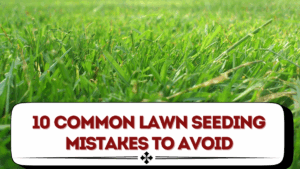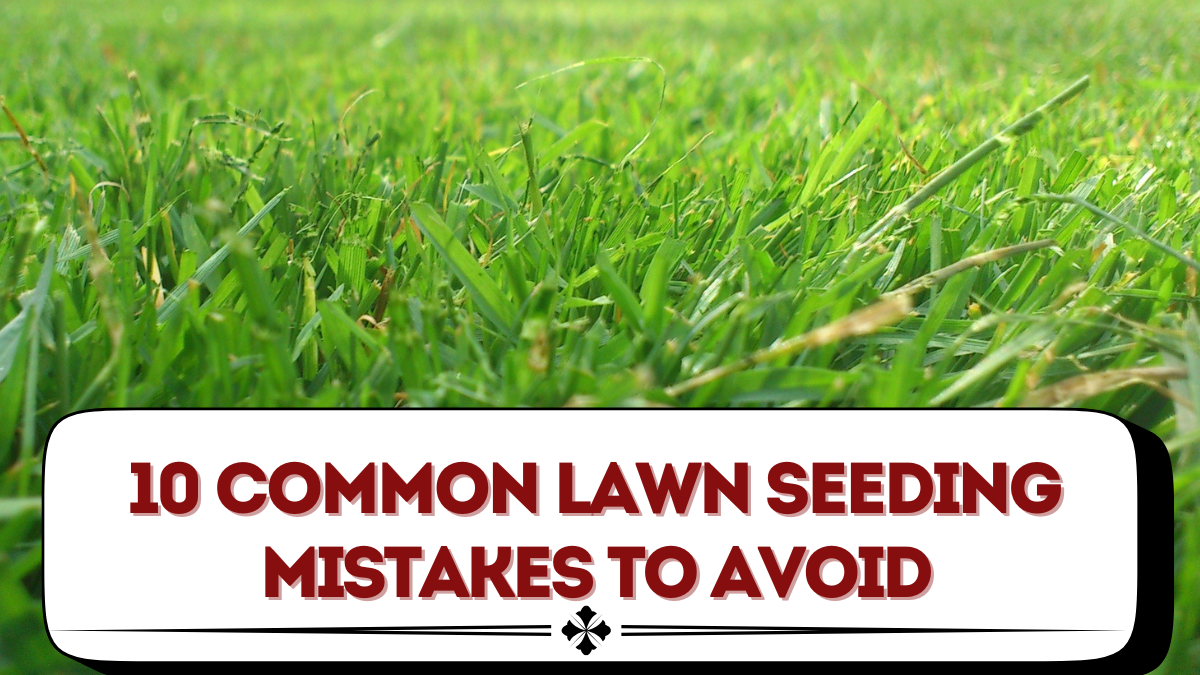Seeding a lawn might look simple, but many homeowners end up with patchy grass or poor germination because of small errors. The truth is, lawn seeding requires precision in timing, soil preparation, watering, and aftercare. Even a minor misstep can undo weeks of effort. By learning the most common lawn seeding mistakes, you can avoid wasted money and ensure a healthy, green lawn that thrives season after season.
This guide highlights the top 10 mistakes people make when seeding lawns, along with practical solutions to get the best results.

1. Choosing the Wrong Seed
Not all grass seeds are the same. Using a type that doesn’t suit your climate or lawn conditions is a leading cause of failure.
-
Cool-season grasses (like fescue, rye, and bluegrass) grow best in cooler regions.
-
Warm-season grasses (like Bermuda, zoysia, and St. Augustine) thrive in hot climates.
Always select grass varieties suited to your location, soil type, and sun exposure.
2. Poor Soil Preparation
Skipping soil prep is one of the biggest seeding errors. Seeds need contact with loose, fertile soil to germinate. Hard, compacted soil prevents roots from developing.
Solution:
-
Till or aerate the soil before seeding.
-
Mix in compost or topsoil for better fertility.
-
Test soil pH and adjust with lime or sulfur if needed.
3. Planting Seeds Too Deep or Too Shallow
Improper seed depth is a common problem. If planted too deep, seeds won’t reach the surface. Too shallow, and they dry out quickly.
Best practice: Plant seeds at about ¼ inch depth and lightly rake soil over them for good contact.
4. Overseeding Too Heavily
Many homeowners believe more seeds mean better lawns, but overseeding too heavily causes overcrowding. Grass seedlings compete for sunlight, nutrients, and water, leading to weak growth.
Solution: Follow the recommended seeding rate on the package for even coverage.
5. Incorrect Timing
Timing is everything in seeding. Planting in the wrong season drastically reduces germination.
-
Cool-season grasses: Seed in early fall or spring.
-
Warm-season grasses: Seed in late spring or early summer.
Avoid seeding during extreme heat or frost.
6. Skipping Starter Fertilizer
Grass seedlings require a nutrient boost to establish roots. Without fertilizer, they may sprout but fail to thrive.
Tip: Apply a balanced starter fertilizer rich in phosphorus (if allowed in your area) at seeding time.
7. Improper Watering
Watering mistakes—either too much or too little—are among the most damaging.
-
Overwatering drowns seeds and encourages disease.
-
Underwatering dries them out before they can sprout.
Solution: Water lightly and frequently until germination, then reduce frequency while increasing depth of watering.
8. Ignoring Weed Control
Seeding without addressing weeds first can result in grass struggling to compete. Weeds consume nutrients and block sunlight.
Solution:
-
Use pre-emergent herbicides before seeding, but only those safe for new grass.
-
Or manually remove weeds before planting seeds.
9. Not Protecting Seeds from Birds and Traffic
Unprotected seeds are easy food for birds and can be disturbed by pets or foot traffic.
Solution: Cover seeded areas with a thin layer of straw or biodegradable mulch to protect seeds until they establish.
10. Lack of Aftercare
Many homeowners stop caring for the lawn once seeds sprout. However, young grass requires ongoing maintenance.
-
Keep soil moist for several weeks.
-
Avoid mowing until grass reaches 3–4 inches.
-
Fertilize after 6–8 weeks for continued growth.
Comparison: Common Mistakes and Fixes
| Mistake | Impact | Fix |
|---|---|---|
| Wrong seed choice | Poor adaptation | Select grass suited to climate |
| Poor soil prep | Weak germination | Aerate and amend soil |
| Planting too deep/shallow | Seeds fail to sprout | Maintain ¼ inch depth |
| Overseeding | Thin, weak grass | Follow package rates |
| Wrong timing | Low germination | Plant in proper season |
| No fertilizer | Weak roots | Use starter fertilizer |
| Over/under watering | Seed loss | Light, frequent watering |
| Weed presence | Competition for resources | Remove weeds before seeding |
| No protection | Seeds eaten/lost | Use straw/mulch cover |
| Lack of aftercare | Patchy lawn | Continue watering and mowing properly |
This table gives a clear overview of how to avoid the most frequent lawn seeding mistakes.
FAQs
What is the best time to seed a lawn?
It depends on the grass type—early fall for cool-season grasses and late spring for warm-season varieties.
Should I fertilize before or after seeding?
Apply starter fertilizer during seeding to provide nutrients for root development.
How long should I water after seeding?
Water lightly and frequently until seeds germinate, then switch to deep watering 2–3 times per week.
Can I walk on a newly seeded lawn?
Avoid walking on it until the grass has reached 3–4 inches in height to prevent damage.
Do I need to overseed every year?
Not necessarily. Overseed only when your lawn is thinning or after dethatching/aeration.
Conclusion
Seeding your lawn successfully requires more than just spreading grass seed—it’s about timing, soil preparation, proper depth, watering, and aftercare. By avoiding these 10 common lawn seeding mistakes, you can achieve a dense, healthy lawn that resists weeds, pests, and drought. With the right strategy, every seed you plant has the potential to grow into a lush green carpet that enhances your home’s beauty.
Click here to know more.
